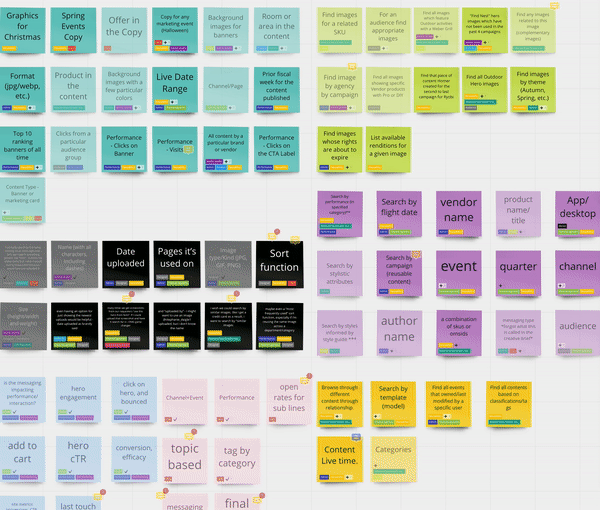THE HOME DEPOT
Enabling marketers and designers to support personalized marketing
Role: Enterprise UX Designer ; I lead research and design of an enterprise product that enables designers, marketers, authorship teams – anyone who needs to reuse content across channels-to find the right content with ease.
Duration: 8 Months, Shipped in 2021
The Home Depot, Inc., is the world’s largest home improvement retailer with annual revenue of over $151B. Delighting their customers—whether do-it-yourselfers or professionals—by providing the home improvement products, services, and equipment rentals they need, when they need them, is key to their success. To maximize value for the increasing number of online shoppers, THD shifted from event marketing to personalized marketing.
In an attempt to create relevant content for their audiences, marketers were operating with a set of disparate digital tools that lacked a common language or data structure. There was no clear picture of how these content assets could be used across channels to keep a united front as marketers. This created a staggering amount of duplicative creative work each fiscal week.
The Solution
My work on this project served as the strategic underpinning for a content recommender tool for marketers within The Home Depot’s CMS that launched in early 2022, powered by centralized content metadata. It was reported that the product shipped with a positive reception of the level of visibility and ease of repurposing content that this product provided for the marketers.
Process
Stakeholder Interviews: I spent significant time at the start of the project interviewing our stakeholders at The Home Depot to get a documented understanding of their business goals and the opportunities and challenges they saw.
User Interviews: I recruited users of different roles within the marketing organization to interview and shadow their use of their current tools and processes. These interviews allowed me to really understand the jobs the users are trying to get done and to identify places where centralized content metadata would help them most.
Process Mapping: I worked through a series of collaborative workshops where we mapped out in detail the end-to-end 6-week campaign process. From these workshops, I paired with my product manager to converge on a hypothesis and a proof of concept for how the platform being built should ideally unite these disconnected content teams
Design: With a deep understanding of the content creation process, I designed an interface utilizing Contentful’s F36 design system to incorporate this product into the new content management system.
Content metadata, or data about data, was living in disparate places within the content ecosystem which detracts from visibility and prohibits reusability and interoperability . It’s essentially what allows a user to search for content. As a result, designers spend an absurd amount of time creating repetitive, visually similar content , fiscal week after fiscal week. For the business, this means that the true value is not gained from investments made into manual content production. There is no visibility into asset performance due to the multiple “hacks” that content creators use just to get a piece of content designed and published. It’s a problem that compounds everyday in a living, breathing content ecosystem.
If performance and usage data are recorded and attributed as metadata for content, then it can enable data-driven decisioning.
Business goal: Enable full visibility to usage and performance of assets, prohibit costly and redundant content creation
User goal: Enable reusability and visibility of content and atomic assets across channels, authors and audiences.
The project started quite ambiguous. As research results were synthesized, a clearer path emerged.
Proof of Concept and Ideation
After a period of research and interviews to completely capture the problems from a user lens throughout the content creation workflow, our validated assumptions led to the concrete understanding that the search capability is where metadata meets the user in a tactical sense. Features that enable users to leverage metadata include: advanced search capabilities, sort capabilities, recommendation capabilities and keyword searches in the CMS. It was decided that a knowledge graph would be the basis of this. Knowledge Graphs are data structures that connect entities or instances with other entities and instances through relationships.
Through design workshops, I gathered possible queries from roles across the content creation journey by simply asking “What do you want to know about content and assets?” Patterns were visible, indicating relationships between queries. This was the basis to select the appropriate metadata attributes that would prove this concept.
The research converged to determine that centralizing content metadata via cloud technology can lay the foundation for enabling automated, dynamic & hyper-personalized assembled content in the future.
Outputs
Through the course of over 20+ interviews, my synthesis converged to create multiple artifacts that distilled the content creation journey to stakeholders, as well as artifacts to support designers across interdependent products. Sensitive content is redacted.
The search capabilities designed into the CMS were the result of our team’s research, and all metadata included for the proof of concept was manually recorded and aggregated from over 100 sources of metadata.




